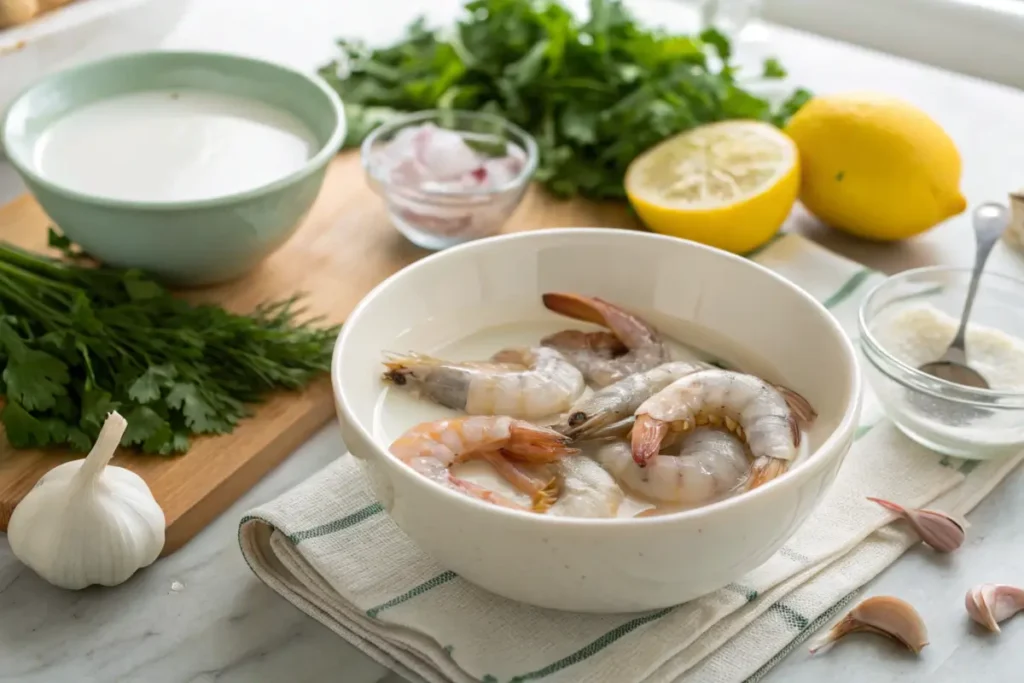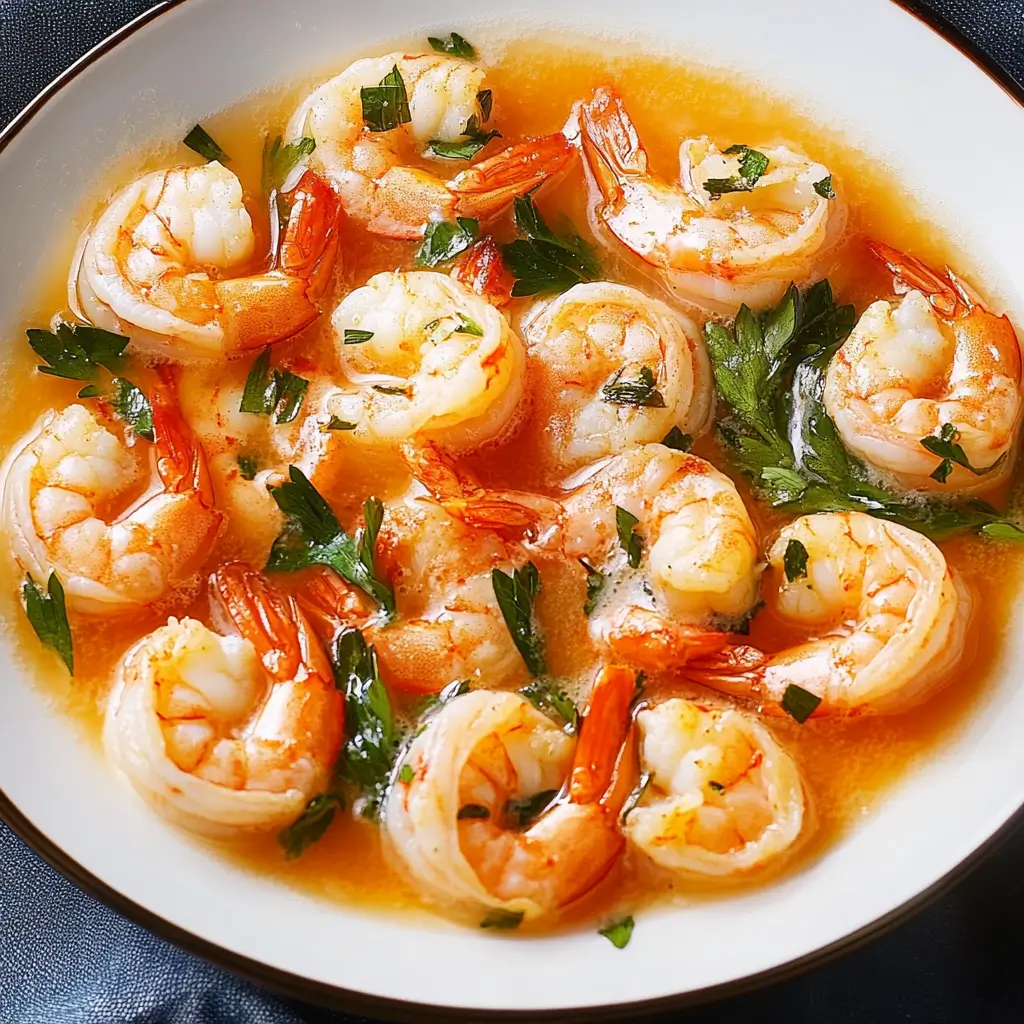Why do you soak shrimp in milk before frying? This simple yet effective technique enhances the texture, flavor, and overall quality of fried shrimp. Cooking is as much about science as it is about art, and this method beautifully blends both. Whether you’re a home cook or an aspiring chef, understanding why milk works as a marinade can transform your shrimp from good to extraordinary. In this article, we’ll explore the reasons behind this practice, uncover its scientific benefits, and share expert tips for achieving perfectly fried shrimp.
Table of Contents
What Is the Practice of Soaking Shrimp in Milk?
Soaking shrimp in milk might seem unconventional at first glance, but it’s a tried-and-true technique in culinary circles. This method involves submerging raw shrimp in milk for a short period before preparing them for frying. Milk isn’t just a cooking ingredient; it acts as a preparatory step that can work wonders on your seafood.
By doing this, cooks aim to neutralize odors and enhance the shrimp’s natural flavors. While it’s often associated with fried shrimp recipes, this technique can also be adapted for other cooking methods.
A Brief History: Origins and Popularity in Cooking
Though the exact origin of this practice is hard to pin down, chefs and home cooks worldwide have long used milk as a marinating agent for seafood. Why? Milk’s unique combination of proteins and fats interacts with the natural enzymes in shrimp, creating a smoother texture and mild taste. This technique likely gained traction as cooks discovered its effectiveness in masking the sometimes overpowering fishy smell of shrimp.
Over time, this practice became a hallmark of well-prepared fried shrimp dishes, especially in Southern cuisine where the focus is often on bold yet balanced flavors.
How Milk Bath Improves Shrimp Preparation
Soaking shrimp in milk goes beyond the surface. The milk helps break down some of the tougher proteins in shrimp, resulting in a tender, juicy bite after frying. Furthermore, this process makes the shrimp’s exterior better suited to holding a crispy batter, ensuring every bite is crunchy and satisfying.
The Science Behind the Technique
Milk as a Natural Tenderizer: Breaking Down Proteins
Milk works its magic on shrimp by acting as a natural tenderizer. It contains enzymes and proteins that interact with the shrimp’s structure, breaking down tough proteins and creating a softer, more succulent texture. This process ensures your fried shrimp is tender and juicy, avoiding that rubbery texture everyone dreads. In culinary science, this protein reaction is known as enzymatic hydrolysis, and it’s why soaking shrimp in milk before frying yields consistently better results.
But the benefits don’t stop there. The lactic acid in milk gently enhances the shrimp’s natural flavors without overpowering them, allowing the seafood’s fresh taste to shine through.
Neutralizing Odors: Why Milk Removes Fishy Smells
Let’s face it: shrimp can sometimes carry a fishy odor that’s less than appetizing. Milk effectively neutralizes these odors, thanks to its ability to bind with trimethylamine, the compound responsible for the fishy smell. By soaking shrimp in milk, you not only improve its flavor but also ensure it smells fresh and clean before hitting the frying pan.
This odor-neutralizing property is particularly useful if you’re preparing a dish for someone sensitive to strong seafood smells. It’s a subtle yet impactful step that elevates the overall experience of eating fried shrimp.
Enhancing Texture and Flavor: Prepping Shrimp for Frying
When you soak shrimp in milk, you’re not just tenderizing or deodorizing it; you’re also laying the foundation for a perfectly crispy and flavorful fry. The milk’s fats coat the shrimp, creating a natural barrier that locks in moisture during frying. This step also helps the batter adhere better, resulting in that mouthwatering crunch we all love in fried seafood.
Moreover, milk’s mild sweetness balances out any briny or salty undertones in the shrimp, giving you a well-rounded flavor profile.
For more insights on seafood preparation techniques, check out this recipe for shrimp bowls.
Step-by-Step Guide to Soaking Shrimp in Milk

Choosing the Right Milk for Soaking Shrimp
When it comes to soaking shrimp, not all milk is created equal. While regular whole milk is the most commonly used, buttermilk is another excellent option. Buttermilk’s acidity can add an extra layer of tenderization, making it ideal for those who love extra juicy shrimp. For those seeking dairy-free alternatives, almond milk or coconut milk can also work, though they may impart a slight nutty or sweet flavor.
How Long to Soak Shrimp in Milk
Timing is everything when soaking shrimp in milk. A short soak of 20 to 30 minutes is usually sufficient to achieve the desired results. Over-soaking can lead to an overly soft texture, so it’s essential to set a timer and keep an eye on the clock.
Before soaking, ensure the shrimp are peeled and deveined. Submerge them in the milk completely, allowing every surface to benefit from the tenderizing and odor-neutralizing effects.
Do’s and Don’ts of Milk-Soaking Shrimp
- Do use fresh milk to avoid any off-flavors in the shrimp.
- Do pat the shrimp dry with paper towels after soaking to ensure your batter adheres perfectly.
- Don’t reuse the milk after soaking shrimp, as it may harbor bacteria from the raw seafood.
- Don’t soak frozen shrimp directly; always thaw them completely before soaking for the best results.
By following these steps, you’ll unlock the full potential of soaking shrimp in milk before frying, ensuring a dish that’s tender, flavorful, and irresistibly crispy.
Pair these milk-soaked shrimp with side dishes like buttery garlic green beans—find the recipe here.
Benefits of Milk-Soaking for Fried Shrimp
Improved Taste and Crispiness
One of the standout advantages of soaking shrimp in milk before frying is the way it enhances both the flavor and texture. The milk’s natural fats coat the shrimp, allowing the batter to stick better. This results in a golden, crispy crust that’s evenly cooked and irresistibly crunchy. Whether you’re making a simple fried shrimp dish or creating a base for something more complex, this extra step makes a noticeable difference.
Additionally, milk-soaked shrimp retain their moisture during frying, ensuring they don’t dry out. This balance between the crispy exterior and juicy interior is what transforms ordinary fried shrimp into something extraordinary.
Reduction of Shrimp Toughness After Cooking
Shrimp that’s overcooked can quickly become rubbery. By pre-soaking shrimp in milk, you effectively counteract this issue. The milk’s enzymes gently break down proteins, making the shrimp more tender even after being exposed to high heat. This is especially useful for fried shrimp, where the cooking process happens quickly.
For those who enjoy experimenting with recipes, this technique can also be adapted for other seafood like calamari or scallops, ensuring a consistently tender bite. Curious about other preparation methods for seafood? Explore how to prepare shrimp and noodles for your next meal.
Better Batter Adhesion: Why It Matters
A poorly adhered batter can ruin a fried dish, but soaking shrimp in milk creates a subtle layer that binds the batter to the shrimp seamlessly. This means fewer bald spots and an even coating, which translates into an even fry. Plus, with the added flavor enhancement from the milk, your fried shrimp will pack a punch of taste in every bite.
Exploring Alternative Ingredients to Milk
Substitutes for Milk in Soaking Shrimp Before Frying
While milk is the classic choice for soaking shrimp, there are plenty of alternatives that can deliver similar results. Buttermilk, with its tangy and slightly acidic profile, is an excellent option. It not only tenderizes the shrimp but also adds a subtle depth of flavor. Lemon juice, another common substitute, works wonderfully for a more citrus-forward dish. Other options, such as yogurt or almond milk, can also be used, though they may slightly alter the final taste.
The key to understanding these substitutions lies in recognizing why you soak shrimp in milk before frying. Milk’s proteins tenderize the shrimp and help reduce odors, and many of these alternatives mimic those properties while adding unique flavors.
When to Use Milk Versus Alternatives
The decision between using milk or its substitutes often depends on the recipe and personal preference. If you want a traditional fried shrimp experience, milk is the best choice. However, for recipes requiring a tangy or nutty twist, options like buttermilk or almond milk can elevate the dish. Knowing why you soak shrimp in milk before frying also helps determine when to lean on these alternatives for creative twists.
For guests with dietary restrictions, such as lactose intolerance, coconut milk or almond milk offers excellent dairy-free options without compromising on results. These alternatives still provide the tenderizing and odor-neutralizing benefits essential for perfectly fried shrimp.
Flavor Variations with Different Soaking Liquids
Experimenting with different soaking liquids can lead to delightful flavor combinations. For instance, coconut milk imparts a sweet, tropical essence, ideal for pairing with spicy or Asian-inspired shrimp recipes. Beer or wine, used sparingly, can infuse seafood with earthy or fruity undertones for gourmet presentations.
By tailoring the soaking liquid to your desired flavor profile, you can adapt this technique to various cuisines. Just remember, understanding why you soak shrimp in milk before frying allows you to explore these alternatives confidently while maintaining the benefits of tender, flavorful shrimp.
Pairing Milk-Soaked Fried Shrimp with Sides and Sauces
Best Sides to Serve with Shrimp Soaked in Milk Before Frying
The perfect fried shrimp dish deserves equally delightful sides. When you understand why you soak shrimp in milk before frying, it becomes easier to create a balanced meal that complements the shrimp’s tender texture and enhanced flavor. Creamy coleslaw is a classic option that pairs its tangy crunch with the crispy goodness of fried shrimp. Alternatively, sides like garlic butter green beans or steamed asparagus offer a healthy contrast while keeping the dish light and fresh.
If you’re craving something more indulgent, creamy mashed potatoes or cheesy grits are excellent choices that highlight the savory notes of the shrimp. For a Southern twist, try pairing milk-soaked shrimp with cornbread or hush puppies to complete a comforting, hearty meal. These options add variety while letting the shrimp take center stage.
Sauces That Elevate Shrimp Prepared with Milk Soaking
No fried shrimp dish is complete without the perfect dipping sauce. The mild, slightly sweet flavor of shrimp, especially when enhanced by milk soaking, pairs beautifully with a variety of sauces. Classic options like zesty cocktail sauce or creamy remoulade never fail to impress. For a spicy kick, serve your shrimp with sriracha mayo or Cajun aioli.
If you’ve chosen an alternative to milk for soaking, such as coconut milk, match your shrimp with sauces that complement those flavors. Coconut milk-soaked shrimp pairs wonderfully with sweet chili sauce or tangy mango salsa, adding a tropical flair to your dish. Understanding why you soak shrimp in milk before frying allows you to choose sauces that harmonize with your shrimp’s unique taste and texture.
Pro Tip: Always serve sauces on the side to keep the shrimp’s crispy coating intact. This ensures every bite is as crunchy and flavorful as it should be.
Experimenting with Milk-Soaking for Other Seafood
Can You Soak Other Seafood in Milk Before Frying?
Absolutely! While the focus here is on why you soak shrimp in milk before frying, this versatile technique works wonders for other seafood as well. Fish like cod, tilapia, or salmon benefit greatly from milk soaking, as it helps neutralize strong odors and improves the overall texture. Even delicate seafood like scallops and calamari can be enhanced with a quick milk bath.
Understanding why soaking seafood in milk is effective can help you achieve consistently tender and flavorful results. Whether you’re preparing a seafood medley or a single type of fish, this technique ensures your dishes are free from overpowering smells and perfectly prepared for frying or other cooking methods.
Tailoring Soaking Times for Milk-Soaking Different Seafood
The duration of milk-soaking varies depending on the type of seafood. Shrimp typically require only 20–30 minutes to achieve the best results, but thicker cuts of fish, such as cod or salmon, may benefit from a longer soak—around 1–2 hours. For delicate seafood like scallops and calamari, a shorter soak of 10–15 minutes is usually sufficient to enhance texture without making it overly soft.
When experimenting with why you soak shrimp in milk before frying, apply the same principles to other seafood. Adjusting the soaking time ensures you achieve the perfect balance of tenderness and flavor while maintaining the natural qualities of each type of seafood. Over-soaking can lead to mushy textures, so always monitor the timing carefully.
Pro Tip: For seafood with an especially strong odor, such as mackerel, adding a squeeze of lemon juice to the milk can amplify the odor-neutralizing effects. This simple trick enhances the versatility of milk soaking across a variety of recipes..
Frequently Asked Questions About Milk-Soaking Shrimp
Why do you soak shrimp in milk before frying?
Soaking shrimp in milk before frying helps tenderize the shrimp, neutralize any strong odors, and create a foundation for a crispy, evenly fried coating. This simple technique enhances both flavor and texture, making it a popular step for fried shrimp recipes.
How long should you soak shrimp in milk?
Typically, shrimp should be soaked in milk for 20–30 minutes. This time frame is sufficient to achieve the desired tenderization and odor-neutralizing effects without compromising the shrimp’s texture.
Can you use alternatives to milk for soaking shrimp?
Yes, you can use alternatives like buttermilk, coconut milk, almond milk, or even citrus juices. Each substitute brings unique flavor profiles while maintaining similar benefits, making them ideal for dietary restrictions or specific recipes.
Does soaking shrimp in milk remove the fishy smell?
Yes, milk is highly effective at neutralizing the fishy smell in shrimp. The milk binds with the compounds responsible for the odor, such as trimethylamine, leaving the shrimp smelling fresh and clean.
Conclusion
In the culinary world, small steps can make a big difference. Soaking shrimp in milk before frying is one such game-changer. This simple technique improves the taste, texture, and quality of fried shrimp. It ensures a dish that’s tender, flavorful, and perfectly crispy. By understanding the science behind milk-soaking, you can elevate your cooking. Experiment with alternatives and pair your shrimp with the right sides and sauces. These steps can transform a simple seafood recipe into a restaurant-quality masterpiece.

